Bitcoin, as a unique asset class, is charting its own course.
Written by: Tanay Ved, Victor Ramirez, Coin Metrics
Translated by: Luffy, Foresight News
Key Points:
The correlation between Bitcoin and stocks and gold has recently dropped to nearly zero, indicating that Bitcoin is in a decoupling phase from traditional assets, a situation that typically occurs during significant market catalysts or shocks.
Although Bitcoin has a low correlation with interest rates, changes in monetary policy can also affect Bitcoin's performance. During the monetary tightening cycle from 2022 to 2023, Bitcoin exhibited a strong negative correlation with interest rate hikes.
Despite being known as "digital gold," historically, Bitcoin has shown a higher beta coefficient and stronger upside sensitivity relative to stocks, especially in optimistic macroeconomic conditions.
Since 2021, Bitcoin's volatility has steadily decreased, and its volatility trend is now closer to that of popular tech stocks, reflecting a maturation of its risk characteristics.
Introduction
Is Bitcoin decoupling from the broader market? Bitcoin's recent strong performance relative to gold and stocks has reignited this discussion. Over its 16-year history, Bitcoin has been labeled many things, from "digital gold" to "store of value" to "risk-on asset." But does it truly possess these characteristics? Is Bitcoin a distinct investment asset, or is it merely a leveraged representation of existing risk assets in the market?
In this edition of the Coin Metrics Network Status Report, we will explore Bitcoin's performance in different market environments, focusing on the catalysts and conditions behind periods of low correlation with traditional assets like stocks and gold. We will also examine how shifts in monetary policy frameworks affect Bitcoin's performance, assess its sensitivity to the broader market, and analyze its volatility characteristics in conjunction with other major assets.
Bitcoin Under Different Interest Rate Regimes
The Federal Reserve is one of the most influential forces in financial markets, as it can affect interest rates. Changes in the federal funds rate, whether in a tightening or easing context, directly impact the money supply, market liquidity, and investors' risk appetite. Over the past decade, we have experienced a transition from a zero-interest-rate era to unprecedented monetary easing during the COVID-19 pandemic, followed by aggressive rate hikes in 2022 to combat rising inflation.
To understand Bitcoin's sensitivity to changes in monetary policy, we divide its history into five key interest rate regime phases. These phases consider the direction and level of interest rates, ranging from accommodative (federal funds rate below 2%) to restrictive (federal funds rate above 2%). Since changes in interest rates are not frequent, we compare Bitcoin's monthly returns with monthly changes in the federal funds rate.
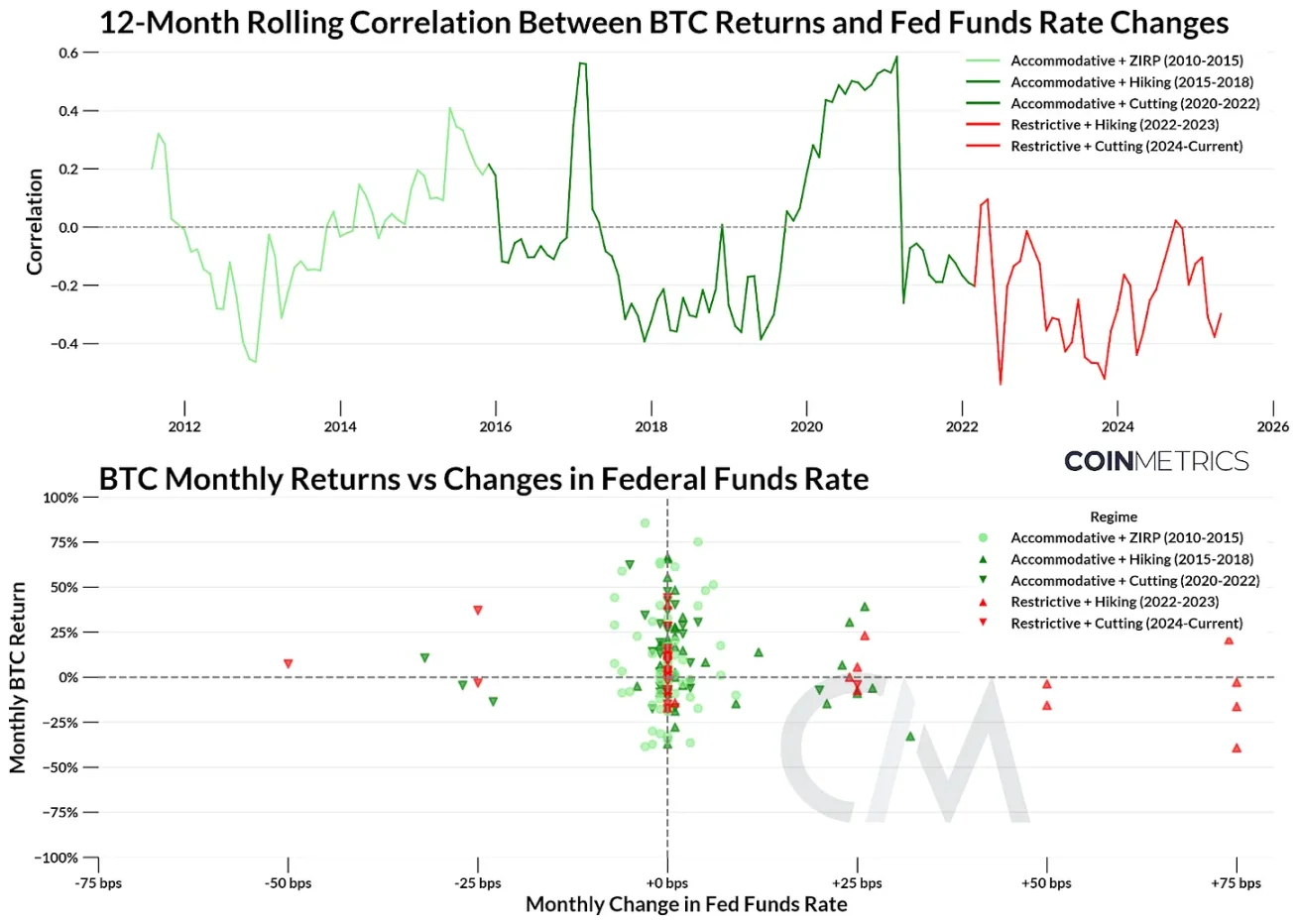
Data Source: Coin Metrics and the New York Federal Reserve Bank
While the overall correlation between Bitcoin and interest rate changes is low and concentrated around the middle level, some clear patterns emerge during shifts in policy regimes:
Accommodative Policy + Zero Interest Rates (2010 - 2015): Driven by the zero-interest-rate policy following the 2008 financial crisis, Bitcoin achieved its highest returns. The correlation with interest rates was roughly neutral, aligning with Bitcoin's early growth phase.
Accommodative Policy + Rate Hikes (2015 - 2018): As the Federal Reserve began raising rates to near 2%, Bitcoin's returns fluctuated. Although correlation spiked in 2017, it remained low overall, indicating some decoupling from macro policy.
Accommodative Policy + Rate Cuts (2018 - 2022): In response to the COVID-19 pandemic, this period saw aggressive rate cuts and fiscal stimulus, followed by two years of near-zero interest rates. Bitcoin's returns varied significantly but leaned positive. During this time, correlation fluctuated dramatically, rising from below -0.3 in 2019 to +0.59 in 2021, before returning to a near-neutral level.
Restrictive Policy + Rate Hikes (2022 - 2023): To combat soaring inflation, the Federal Reserve implemented one of its fastest rate hike cycles, pushing the federal funds rate above 5%. In this regime, Bitcoin exhibited a strong negative correlation with interest rate changes. Under risk-off sentiment, Bitcoin's performance weakened, particularly compounded by shocks unique to the cryptocurrency space, such as the collapse of FTX in November 2022.
Restrictive Policy + Rate Cuts (2023 - Present): Following three high-rate cuts, we see Bitcoin's performance shift from neutral to moderately positive. This period has also seen some catalysts, such as the U.S. presidential election and trade war shocks, continuing to influence Bitcoin's performance. The correlation remains negative but appears to be gradually approaching zero, indicating that as macroeconomic conditions begin to ease, Bitcoin is in a transitional phase.
While interest rates determine the market backdrop, comparing Bitcoin's relationship with stocks and gold can better reveal its performance relative to major asset classes.
Bitcoin Returns Relative to Gold and Stocks
Correlation
To determine whether one asset is decoupling from another, the most direct method is to look at the correlation between their returns. Below is a chart showing the 90-day return correlation between Bitcoin and the S&P 500 index and gold.
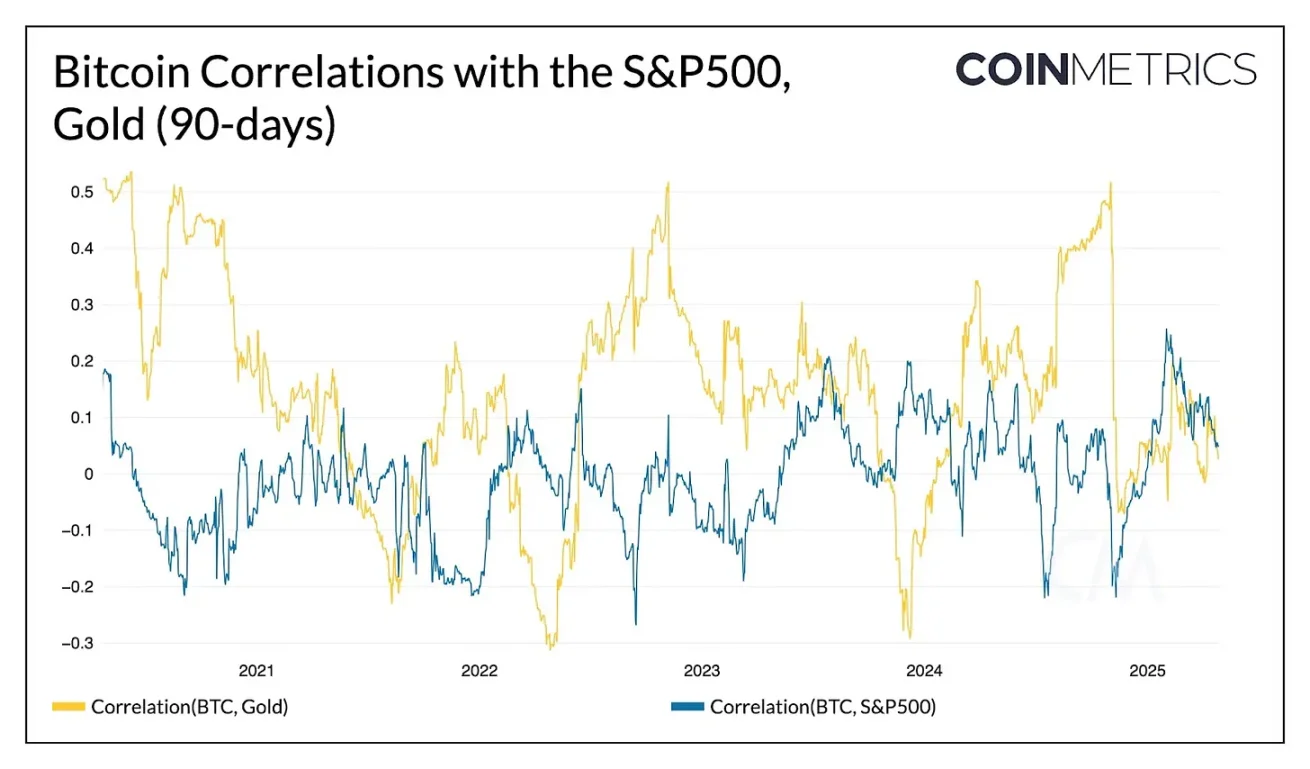
Data Source: Coin Metrics
Indeed, we see that Bitcoin's correlation with both gold and stocks has historically been low. Generally, Bitcoin's returns fluctuate between correlations with gold or stocks, with a higher correlation typically with gold. Notably, as market sentiment heats up, the correlation between Bitcoin and the S&P 500 index increased in 2025. However, starting around February 2025, the correlation between Bitcoin and both gold and stocks trended towards zero, indicating that Bitcoin is in a unique phase of "decoupling" from gold and stocks. This situation has not occurred since the peak of the last cycle at the end of 2021.
What typically happens when the correlation is this low? We compiled periods when the rolling 90-day correlation between Bitcoin and the S&P 500 index and gold fell below a significant threshold (around 0.15) and marked noteworthy events at that time.
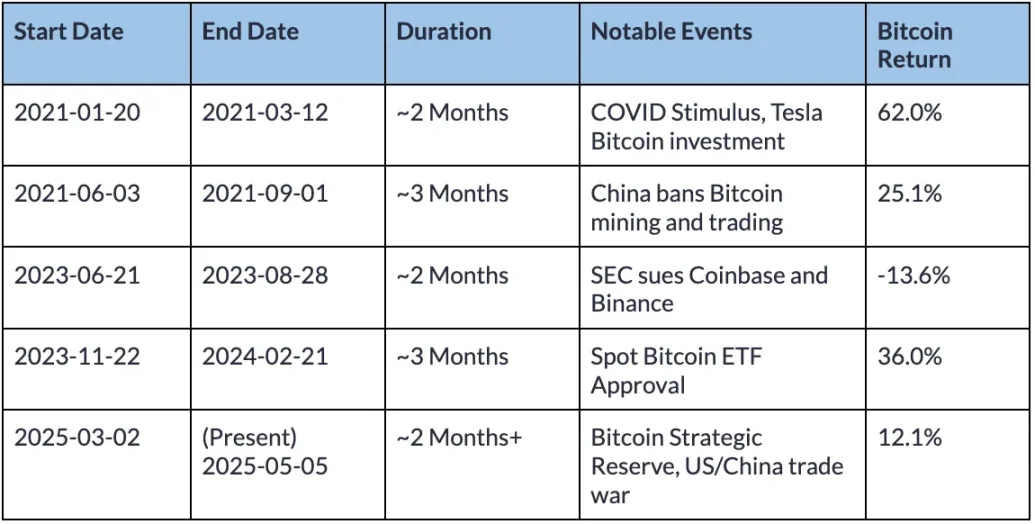
Periods of Low Correlation Between Bitcoin and the S&P 500 Index
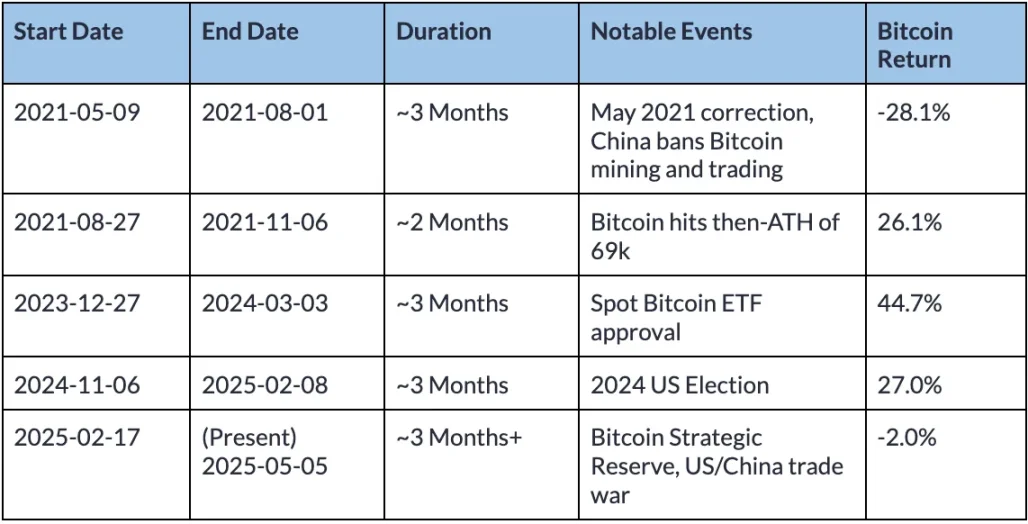
Periods of Low Correlation Between Bitcoin and Gold
Unsurprisingly, past instances of Bitcoin decoupling from other assets occurred during significant shocks in the cryptocurrency market, such as China's ban on Bitcoin and the approval of Bitcoin spot ETFs. Historically, low correlation periods typically last around 2 to 3 months, although this depends on the correlation threshold you set.
These periods indeed accompanied moderate positive returns, but given that each period has its unique characteristics, careful consideration of these unique aspects is necessary before drawing any conclusions about Bitcoin's recent performance. That said, for those looking to allocate a significant portion of Bitcoin in a risk-diversified portfolio, Bitcoin's recent low correlation with other assets is an ideal characteristic.
Market Beta Coefficient
In addition to correlation, the market beta coefficient is another useful metric for measuring the relationship between an asset's returns and market returns. The market beta coefficient quantifies the extent to which an asset's returns are expected to change with market returns, calculated as the sensitivity of the asset's returns minus the risk-free rate relative to a benchmark. Correlation measures the direction and strength of a linear relationship between an asset and benchmark returns, while the market beta coefficient measures the direction and magnitude of an asset's sensitivity to market fluctuations.
For example, Bitcoin is often said to have a "high beta coefficient" relative to the stock market. Specifically, if an asset (like Bitcoin) has a market beta coefficient of 1.5, then when the market benchmark asset (S&P 500 index) changes by 1%, the asset's returns are expected to change by 1.5%. A negative beta coefficient means that when the benchmark asset's returns are positive, the asset's returns are negative.
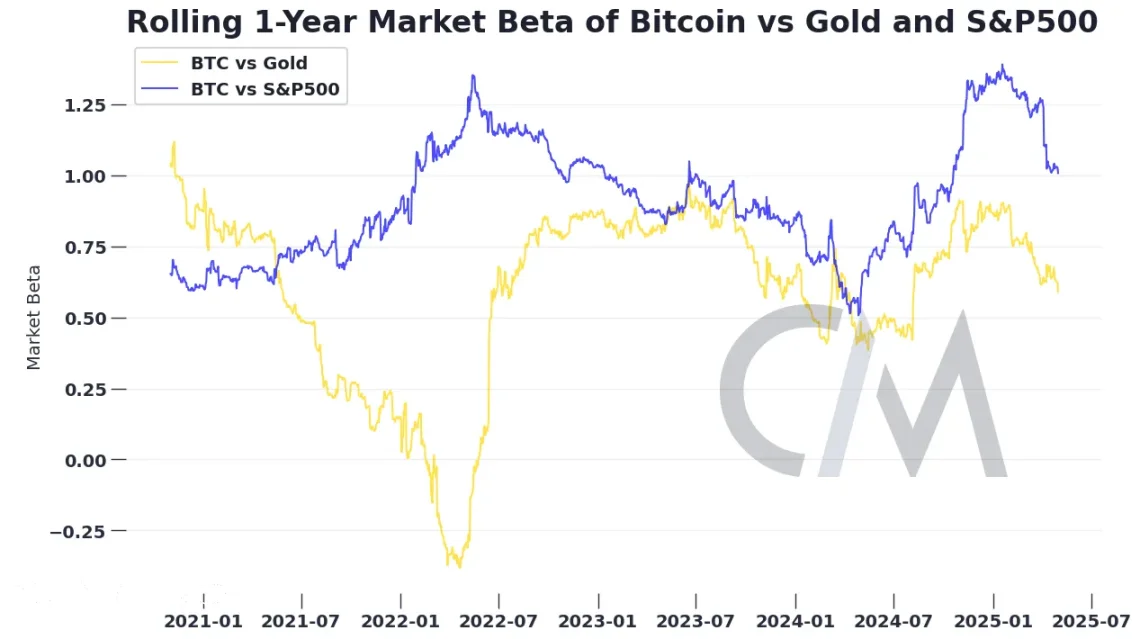
For most of 2024, Bitcoin's beta coefficient relative to the S&P 500 index was well above 1, indicating high sensitivity to stock market fluctuations. In optimistic, risk-on market environments, investors holding a certain proportion of Bitcoin achieved higher returns compared to those holding only the S&P 500 index. Although Bitcoin is often labeled as "digital gold," its low beta coefficient relative to physical gold suggests that holding both assets can hedge against each other's downside risks.
As we move into 2025, Bitcoin's beta coefficient relative to the S&P 500 index and gold begins to decline. Although Bitcoin's dependence on these assets is decreasing, it remains sensitive to market risk, and its returns are still correlated with market returns. Bitcoin may be becoming a unique asset class, but its trading behavior largely remains similar to that of risk-on assets, and there is currently no strong evidence to suggest it has become a "safe-haven asset."
Bitcoin Performance During High Volatility Periods
Realized volatility provides another dimension for understanding Bitcoin's risk characteristics, measuring the extent of Bitcoin's price fluctuations over a period. Volatility is often considered one of Bitcoin's core features, being both a driver of risk and a source of returns. The following chart compares Bitcoin's 180-day rolling realized volatility with the volatility of major indices such as the Nasdaq index, S&P 500 index, and some tech stocks.
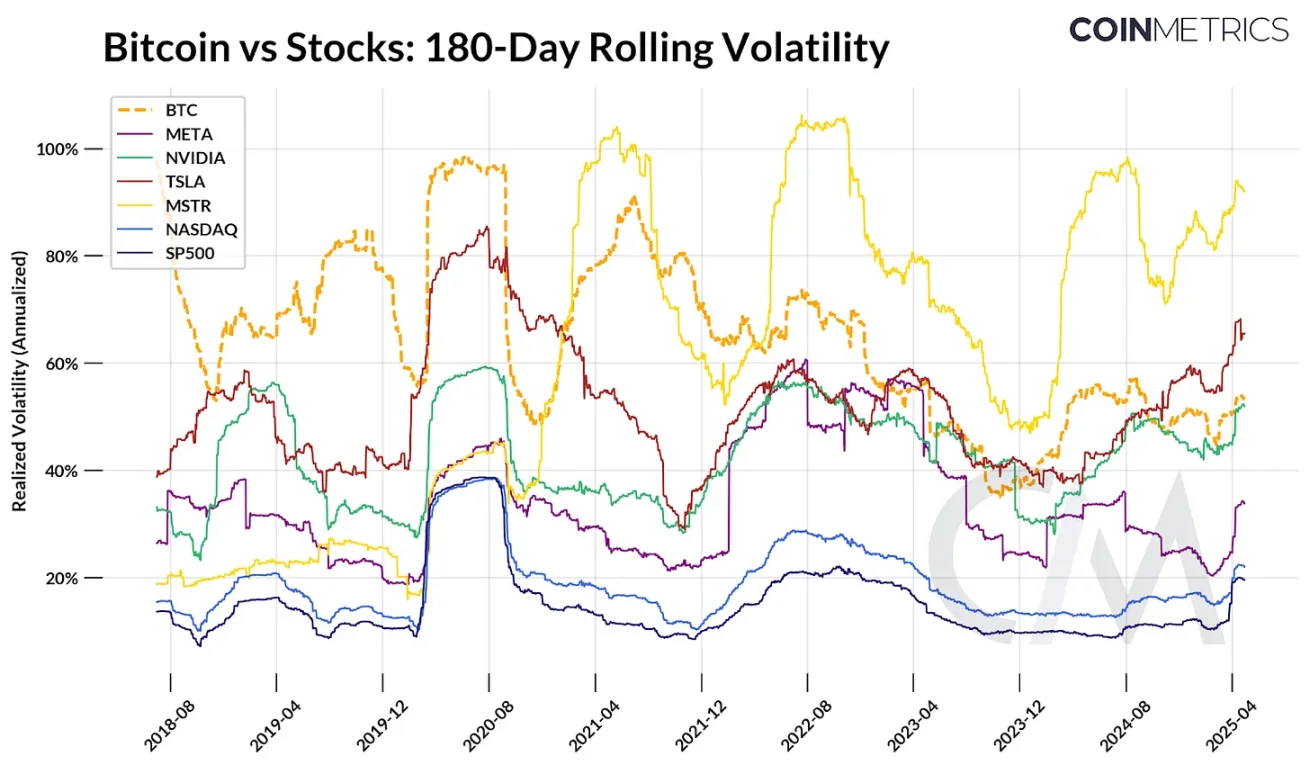
Data Source: Coin Metrics and Google Finance
Over time, Bitcoin's volatility has shown a downward trend. In the early stages of Bitcoin, driven by significant price surges and pullback cycles, its realized volatility often exceeded 80%-100%. During the COVID-19 pandemic, Bitcoin's volatility rose alongside stock volatility, and during certain periods in 2021 and 2022, its volatility also increased independently due to shocks unique to the cryptocurrency space, such as the collapses of Luna and FTX.
However, since 2021, Bitcoin's 180-day realized volatility has gradually decreased, stabilizing around 50%-60% even in times of high market volatility. This makes its volatility comparable to many popular tech stocks, lower than MicroStrategy (MSTR) and Tesla (TSLA), and very close to Nvidia's (NVIDIA) volatility. Although Bitcoin remains susceptible to short-term market fluctuations, its relative stability compared to past cycles may reflect its maturation as an asset.
Conclusion
Has Bitcoin decoupled from other parts of the market? It depends on how you measure it. Bitcoin is not completely unaffected by the real world. It is still subject to market forces that influence all assets: interest rates, specific market events, and the returns of other financial assets. Recently, we have seen the correlation between Bitcoin's returns and other parts of the market disappear, but whether this is a temporary trend or part of a long-term market change remains to be seen.
The question of whether Bitcoin has decoupled raises a larger issue: what role can Bitcoin play in a risk-diversified investment portfolio? The risk and return characteristics of Bitcoin may confuse investors; one week it may resemble a highly leveraged Nasdaq index, the next week it acts like digital gold, and another week it becomes a hedge against fiat currency devaluation. But perhaps this volatility is a feature rather than a flaw. Instead of making imperfect analogies between Bitcoin and other assets, a more constructive approach is to understand why, as Bitcoin gradually evolves into a unique asset class, it is charting its own course.
免责声明:本文章仅代表作者个人观点,不代表本平台的立场和观点。本文章仅供信息分享,不构成对任何人的任何投资建议。用户与作者之间的任何争议,与本平台无关。如网页中刊载的文章或图片涉及侵权,请提供相关的权利证明和身份证明发送邮件到support@aicoin.com,本平台相关工作人员将会进行核查。




